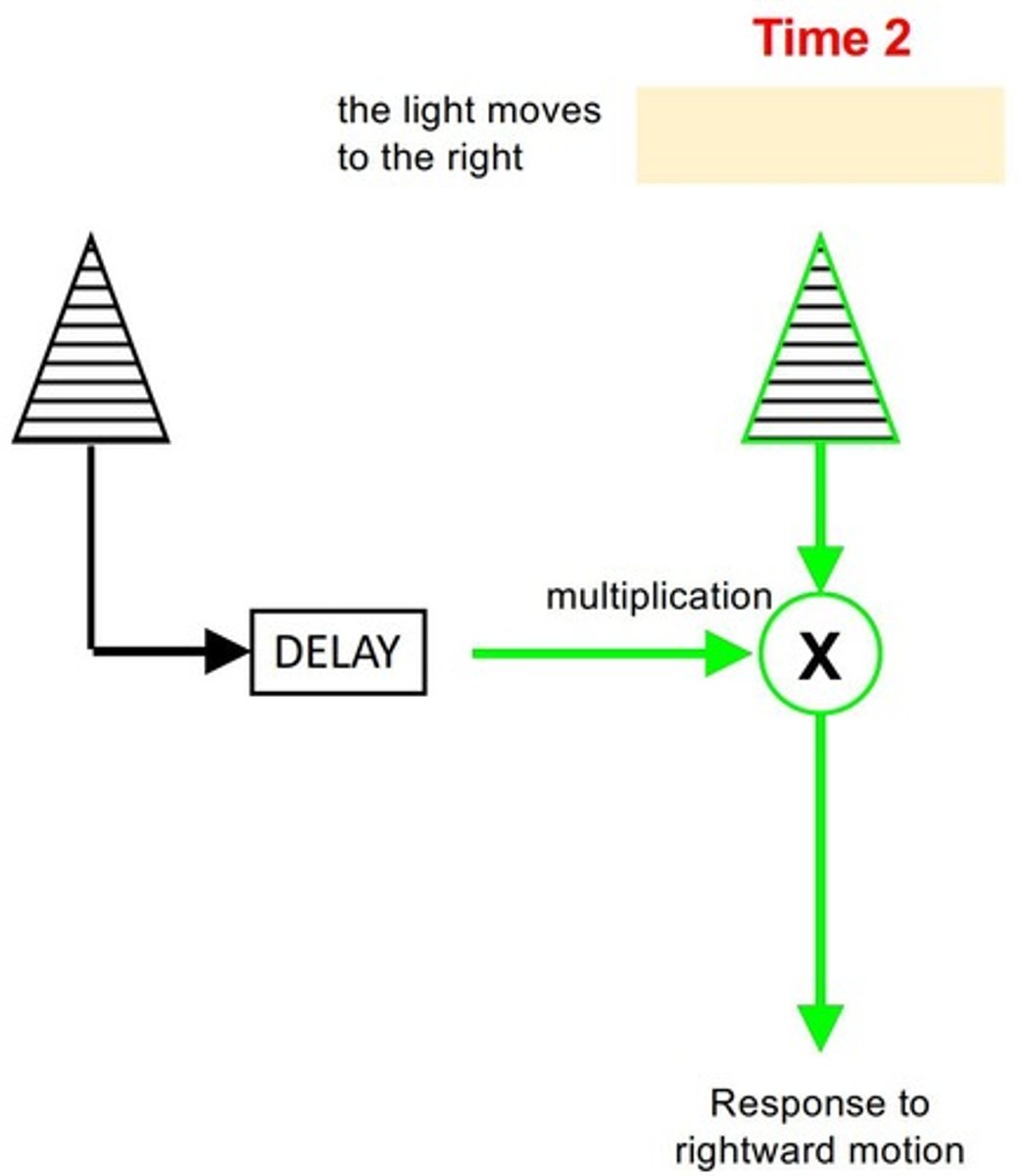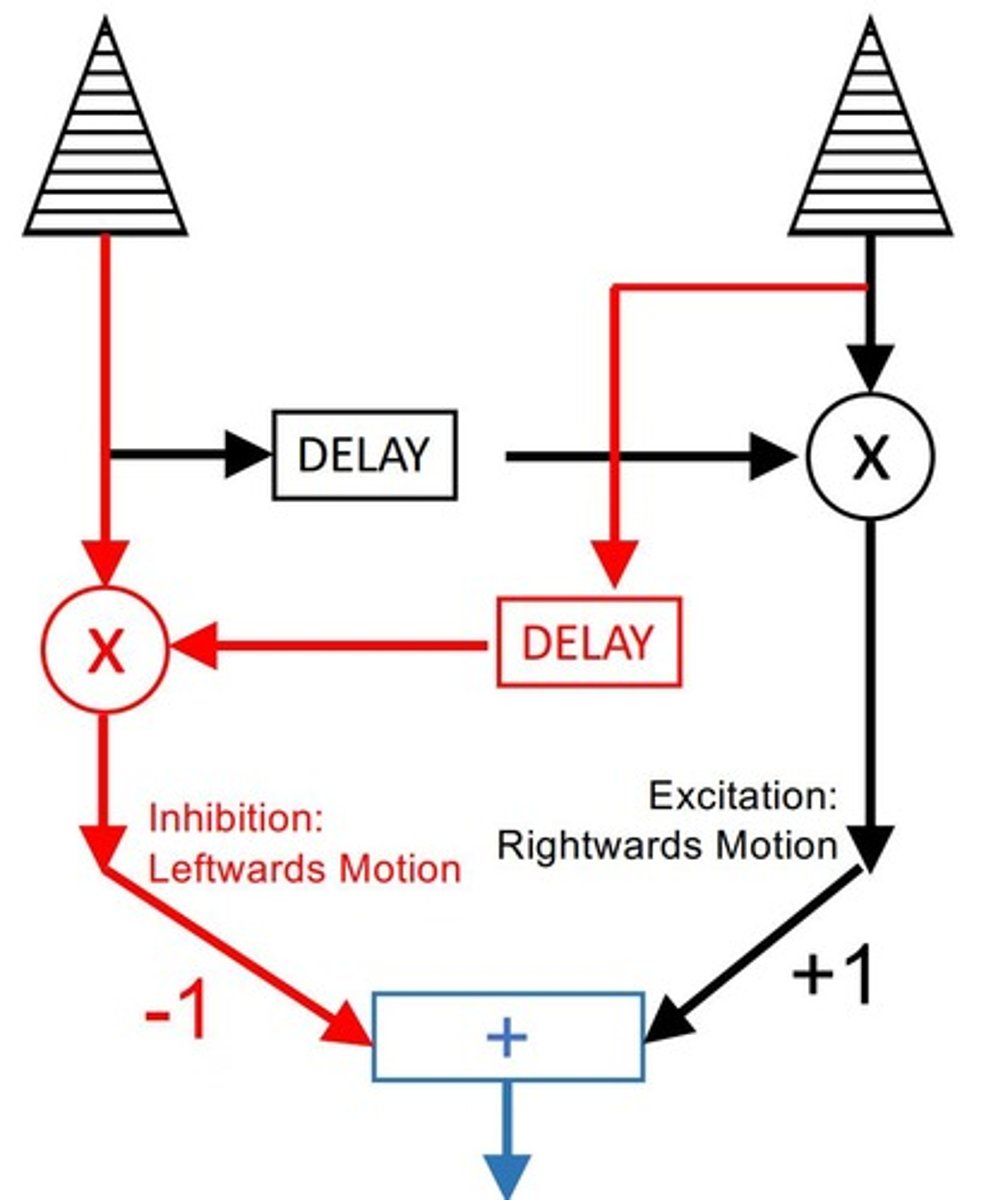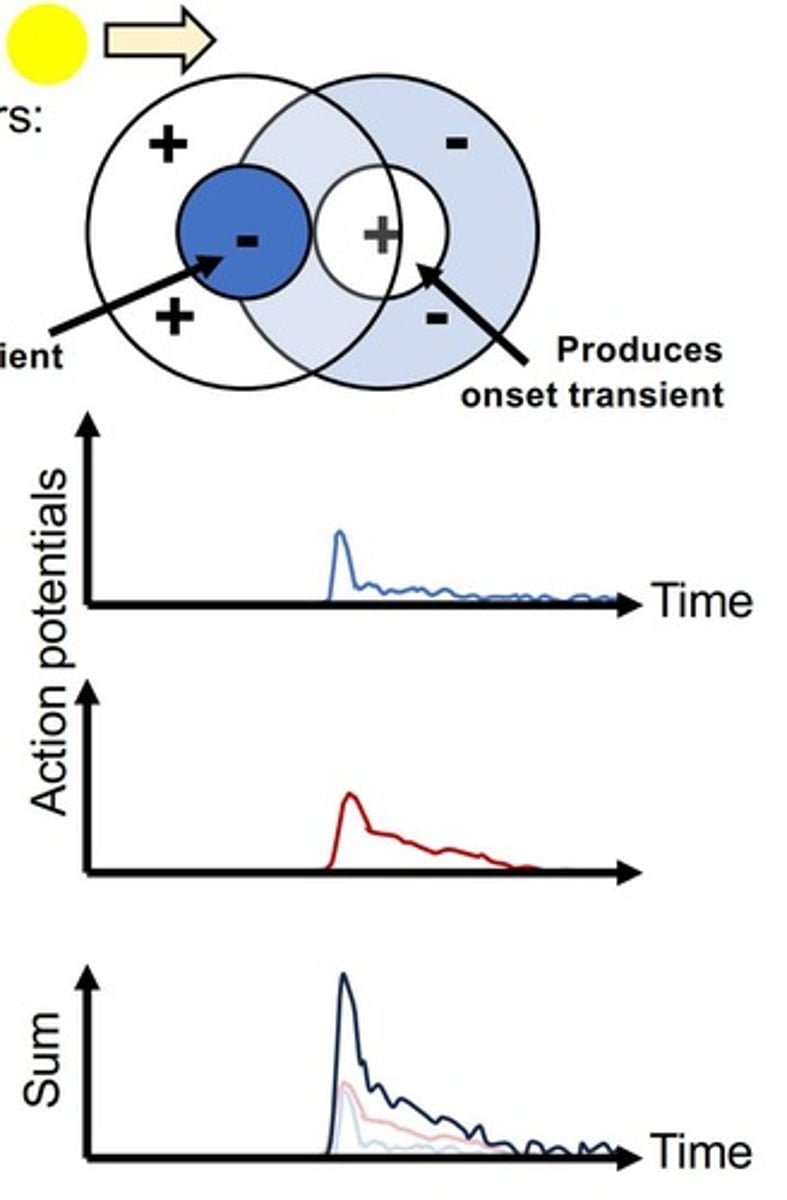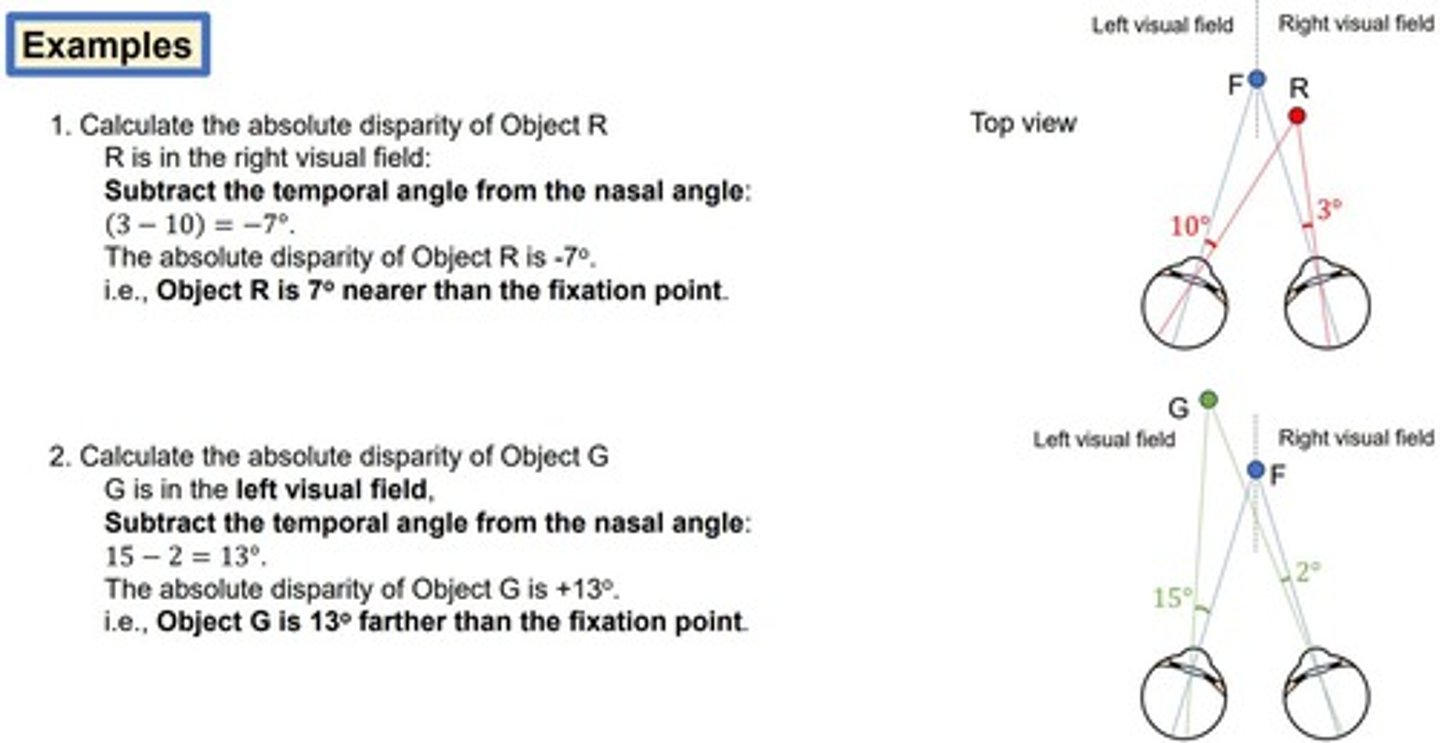Biology of Motion Processing and Visual Perception
1/212
There's no tags or description
Looks like no tags are added yet.
Name | Mastery | Learn | Test | Matching | Spaced |
|---|
No study sessions yet.
213 Terms
What is the first site of the visual hierarchy that detects motion?
V1 is the first site of the visual hierarchy with neurons that definitively detect motion.
How does perception of motion arise in the visual system?
Perception of motion arises from cortical computations, building up extracted features into perception.
What type of neurons are insensitive to color and respond to changes in intensity?
Magnocellular neurons are insensitive to color and only respond to changes in intensity.
What happens at the isoluminant point regarding magnocellular neurons?
At the isoluminant point, magnocellular neurons are no longer active, resulting in no signal conveyed to motion pathways and thus no motion perceived.
Where do magnocellular neurons project in the visual system?
Magnocellular neurons project into the interblobs of V1.
What is direction selectivity in simple cells of V1?
Direction selectivity in simple cells of V1 means they fire in response to certain directions but not others.
What is the relationship between directional tuning and orientation tuning in V1 neurons?
V1 neurons are tuned to both orientation and direction, with directional tuning being orthogonal to orientation tuning.
What is the aperture problem in motion perception?
The aperture problem refers to the limited view/context that makes the direction signal of a straight edge ambiguous and looks orthogonal to orientation.
How are V1 neurons affected by the aperture problem?
V1 neurons have receptive fields that are spatially tuned and prefer single straight edged orientations, but without contextual info, they cannot determine the real direction of movement.
What is the significance of polar plots in visualizing directional tuning of V1 neurons?
Polar plots are used to represent directional tuning and neural responses of directionally tuned neurons to all possible directions.
What does the Hassenstein-Reichardt model describe?
The Hassenstein-Reichardt model is a hypothetical circuit that explains how motion selectivity arises in invertebrate visual systems.

What occurs when steady light shines on both photoreceptors in the Hassenstein-Reichardt model?
Equal excitation and inhibition from both detectors cancel each other out, resulting in no signals elsewhere.
What happens in the Hassenstein-Reichardt model when there is left-right movement?
In left-right movement, the left-right part produces excitatory signals while the right-left part remains silent, resulting in positive net activity.

What is the role of simple cells in humans regarding directional selectivity?
In humans, directional selectivity starts in V1 with simple cells.
What is the effect of local motion on V1 neurons?
V1 neurons sense local direction signals that are orthogonal to orientation without considering global contextual information.
What is spatial tuning in V1 neurons?
Spatial tuning refers to V1 neurons sensing light only within a small region of space.
What is orientation tuning in V1 neurons?
Orientation tuning refers to V1 neurons preferring single straight edged orientations.
How does the visual system build up motion perception?
The visual system builds up motion perception through a hierarchy of processing that extracts features and integrates them.
What is the emergent property of the cortex related to motion?
Motion is considered an emergent property of the cortex.
How do magnocellular neurons contribute to motion perception?
Magnocellular neurons contribute to motion perception by responding to changes in intensity rather than color.
What is the significance of the interblobs in V1?
The interblobs in V1 are significant because they are where magnocellular neurons project and where direction selectivity is first found.
What happens during right-left movement in terms of neural activity?
The right-left part produces inhibition while the left-right part remains silent, resulting in net negative activity.
What are Reichardt Detectors and their limitations in mammals?
Reichardt detectors are models for motion detection that face challenges in mammals, as V1 direction selective neurons receive center-surround signals from the LGN rather than directly from photoreceptors.

How do mammalian direction selective neurons respond to speed?
Mammalian direction selective neurons are not very speed selective; they fire over a wide range of speeds if the movement matches the neuron's preferred direction.
What are the transient responses of LGN neurons?
LGN neurons exhibit transient responses when light is switched on (onset transient) or off (offset transient), independent of spatial properties but dependent on the type of change.
What type of receptive fields produce onset and offset transients in LGN neurons?
Onset transients occur when a stimulus change matches the center of the receptive field, while offset transients occur when the change is opposite of the center.
What is the configuration required for opposing direction selectivity in V1?
Opposing direction selectivity in V1 is achieved by pairing LGN neurons with different receptive fields and synchronizing responses from neurons with ON- and OFF-centers.

How does motion adaptation affect perception of speed?
Prolonged exposure to a moving object causes neurons tuned to that direction to respond less, leading to the perception of slower movement.
What is the motion aftereffect and how is it explained?
The motion aftereffect occurs when a stationary object appears to move in the opposite direction after prolonged exposure to motion in one direction, explained by opponent motion axes.
What is apparent motion and its significance?
Apparent motion refers to the illusory perception of motion created by flashing a series of still images, forming the basis of motion in all digital displays.
How do V1 neurons differ in their response to real and apparent motion?
V1 activity is similar for both real and apparent motion, indicating that the same neural mechanisms are involved.
What is the role of the dorsal stream in motion processing?
The dorsal stream processes motion information from V1, with area MT being crucial for global motion perception.
What is the purpose of Random Dot Kinematograms (RDK) in studying motion perception?
RDKs test global motion perception by varying the proportion of dots moving together to determine the coherence level at which global motion is barely detectable.
What is akinetopsia and its effects on perception?
Akinetopsia is a condition caused by damage to the MT region, resulting in an inability to perceive motion, leading to viewing the world in snapshots.
How does stimulation of MT neurons affect perception of motion?
Electrically stimulating clusters of MT neurons tuned to a specific direction biases an animal's perception, causing them to preferentially report motion in the stimulated direction.
What is the relationship between MT activity and conscious motion perception?
MT is active during the perception of motion, but disruptions in MT signals can slow down the perceived speed of motion.
How do retinal changes contribute to motion perception?
Changes in the pattern of light in receptive fields are typically how neurons sense motion, but motion can also be perceived without changes to the retinal pattern.
What is vection and what causes it?
Vection is the illusory perception of self-motion triggered by observing other objects move, often causing nausea due to conflicting information.
Why do background objects typically not appear to move?
Background objects must move much faster to produce equivalent retinal changes compared to foreground objects, leading the brain to interpret retinal movement as foreground object presence.
What is induced motion and when does it occur?
Induced motion is the misperception that background objects are moving when in reality, they are stationary, often occurring when foreground objects move.
What are the types of global motion detected beyond V1?
Global motion can be planar, circular, radial, or follow other non-linear paths, detected by neurons deep in the visual hierarchy.
How does pooling across directions resolve the aperture problem?
Pooling over different orientations provides a global signal of direction, clarifying true direction when single oriented edges create ambiguity.
What is the significance of MT neurons in global motion perception?
MT neurons are primarily direction selective and respond to global motion, integrating local movements into a coherent percept.

What is the effect of prolonged exposure to a moving object on perception?
Prolonged exposure can lead to desensitization, making the moving object appear stationary or slower.
How do magnocellular ganglion cells contribute to temporal changes?
Magnocellular ganglion cells have large transients and small sustained responses, making them well-suited for detecting temporal changes.
What is the Autokinetic Effect?
The Autokinetic Effect is the perception of motion without contextual background information, leading the visual system to hallucinate motion.
What are the two theories explaining the Autokinetic Effect?
1. Eye Movement Theory: Muscle signals from eye movements cause interpretations of movement. 2. Retinal Theory: Eye movements change the position of light on the retina.
What is self-motion in the context of visual perception?
Self-motion refers to the movements of the observer's eyes, head, or body, which can lead to the perception of a stable world.
What is vection?
Vection is the sensation that occurs when the brain misinterprets object motion as self-motion.
What does Corollary Discharge Theory explain?
Corollary Discharge Theory explains how the brain processes self-motion by comparing the image movement signal from the retina with a copy of the motor command sent to the eye muscles.
What is the role of the comparator in Corollary Discharge Theory?
The comparator receives both the image movement signal and the corollary discharge signal to determine whether the movement is due to self-motion or external motion.
What is the Adaptation After Effect?
The Adaptation After Effect occurs when photoreceptors in the adaptation zone stop signaling to light, leading to a perception of movement even when the eyes are still.
How does Corollary Discharge facilitate eye movement?
Corollary Discharge allows the brain to prepare for intended eye movements, which is crucial as some neurons adjust their receptive fields in anticipation of the final image position.
What is the process of Image Deconstruction and Perceptual Reconstruction?
The front part of the visual system deconstructs 2-D retinal images into individual features, which are then combined to reconstruct a 3-D visual perception.
How does the brain interpret 3-D space from 2-D images?
The brain uses sophisticated computations and combines various cues to infer 3-D vision from 2-D retinal images.
What are the three functions of 3-D vision?
1. Identify object location in 3-D space (Dorsal stream). 2. Identify objects from different viewpoints (Ventral stream). 3. Link object identity to location for appropriate behavior.
What are binocular cues?
Binocular cues are depth cues derived from combining information from both eyes.
What are monocular cues?
Monocular cues are depth cues that can be perceived with one eye alone, including motion, shading, texture, occlusion, size, perspective, and shadows.
What is binocular vision?
Binocular vision is the ability to perceive depth using both eyes with overlapping visual fields.
What is diplopia?
Diplopia is double vision that occurs when objects project onto different parts of the two retinas.
What is strabismus?
Strabismus is a condition where the eyes are misaligned, preventing them from focusing on the same object.
How does strabismus differ from amblyopia?
Strabismus is a muscular problem that can be corrected, while amblyopia is a neural problem that occurs if one eye's input is ignored due to misalignment.
What is binocular disparity?
Binocular disparity is the difference in retinal positions of an object viewed by both eyes, which contributes to depth perception.
What is Panum's fusional area?
Panum's fusional area is a small zone where the brain can combine images from both eyes without diplopia, allowing for single perception.
What are near (crossed) disparities?
Near disparities occur when objects are closer to the observer than the horopter, producing a perception of depth that is nearer than the fixation point.
What are far (uncrossed) disparities?
Far disparities occur when objects are farther from the observer than the horopter, producing a perception of depth that is farther than the fixation point.
What is absolute binocular disparity?
Absolute binocular disparity is the difference in positions of an object on the two retinas, which indicates the object's depth relative to a fixation point.

How is absolute disparity calculated?
Absolute disparity is calculated by measuring the horizontal positions of objects in the left and right eyes and determining the difference.
What is the significance of the foveas in visual perception?
The foveas serve as reference points on the retinas, and objects within Panum's fusional area are perceived as having the same depth as the fixation point.
What happens when binocular disparities cannot be combined by the brain?
When binocular disparities cannot be combined, it results in diplopia, where the brain perceives two separate images instead of a single fused image.
What are near disparities in visual perception?
Negative values.
What are far disparities in visual perception?
Positive values.
How is the computation of absolute disparity determined?
It depends on the side of the retinal field that the object is in.
What is the formula to compute absolute disparity when considering the retinal fields?
Subtract the angle in the temporal retinal field from the angle in the nasal retinal field: 𝛽 − 𝛼 in degree visual angle for the object.
What is the primary source of 3-D depth information for the brain?
Binocular disparities.
How does the brain construct 3-D scenes from retinal images?
By extracting binocular disparities and using them to create a 3-D world.
What is the role of the dorsal stream in stereovision?
Stereovision begins in V1 and is biased towards the dorsal stream, which is associated with the 'where' pathway.
Where do binocular neurons first combine information from the left and right eyes?
In the superficial and deep layers at the interface of ocular dominance columns.
What is the difference between ocular dominance and sighting dominance?
Ocular dominance refers to a neuron's preference for stimulation from one eye, while sighting dominance refers to a person's preference for one eye.
What is a disparity tuning curve?
It shows a neuron's response to differences in image positions on the two retinas.
How do complex cells in the visual cortex achieve binocularity?
By pooling inputs from simple cells derived from both eyes.
What is the difference between local and global disparities in visual perception?
Local disparities are detected by V1 neurons, while global disparities are detected by extrastriate neurons.
What is a random dot stereogram?
A pair of stereo images made up of random dots that create depth perception through binocular disparity.
What is the correspondence problem in stereovision?
The challenge of correctly matching left and right dots in binocular vision.
What are monocular cues to 3-D vision?
Visual cues that provide depth information using only one eye.
What is occlusion in the context of depth perception?
A cue where near objects block the view of far objects, aiding in depth perception.
What is aerial perspective?
A depth cue where distant objects appear blurrier or hazier due to atmospheric effects.
How does linear perspective contribute to depth perception?
It creates the illusion that parallel lines converge as they recede into the distance.
What is Emmert's Law?
It states that the perceived size of an object is proportional to its perceived distance.
What technique is used to objectively quantify neural activity in children?
Electroencephalogram (EEG) to measure electrical activity from neurons.
What is the purpose of visual evoked potentials (VEPs)?
To measure electrical activity in response to visual stimuli.
What is habituation in the context of visual perception in children?
The process where a child loses interest in a familiar object after repeated exposure.
What is dishabituation?
The increase in looking time when a new object is presented after habituation.
What does preferential looking measure in infants?
It assesses contrast sensitivity by observing gaze direction towards patterns.
What is the difference between acuity and contrast sensitivity?
Acuity is the highest visible spatial frequency at maximum contrast, while contrast sensitivity is the lowest visible contrast at each spatial frequency.
What is spatial vision?
It refers to how both eyes and the brain contribute to visual perception.
What is vernier acuity?
A measure of visual acuity that is distinct from standard visual acuity.
What does the term 'binocular neurons' refer to?
Neurons that respond to stimulation from both the left and right eyes.
What is the significance of the gradual transition from left to right eye preference in V1?
It indicates how neurons organize binocularity and process information from both eyes.
How do phase-shifted complex cells contribute to disparity tuning?
They combine large receptive fields with different ON- and OFF-subregions between the eyes.